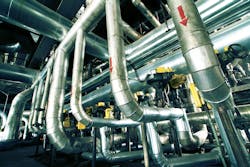Application Corner: Allocating costs for sewage districts
Previous columns described the sewage collection systems for two adjacent sewage districts where sewage from the first sewage district and the combined sewage (sewage plus drainage water) from the second sewage district are treated in a sewage treatment plant owned and operated by the second sewage district.
The billing rate in a given year was apportioned between the sewage districts based on the flow measurements — four outfalls from the first district and one at the inlet to the sewage treatment plant. The previous year’s flow from the first sewage district could be calculated by summing the flows measured through each of the four flowmeters during the previous year.
The total plant flow for the previous year was similarly calculated using the total plant flow measurements during the same time period. The sewage generated by the second district was calculated by subtracting the first sewage district flow from the total plant flow. The resultant proportion of sewage generated by each district could then be used to allocate the cost of operating the sewage treatment plant and calculate the next year’s billing rate for each district.
For example, if the first and second sewage districts deliver 40% and 60% of the liquid to be treated, the customers in the first and second sewage districts would be expected to pay 40% and 60% respectively of the expenses associated with operating the sewage treatment plant. This allocation would then be used to calculate the next year’s billing rate. In addition to being invoiced for the normal daily treatment charges — billing rate multiplied by the daily flow — a surcharge was added to the second district’s bill for flow that exceeded a set amount of sewage during that day.
Read more next month about how wide billing variations can occur on different days.
David W. Spitzer is a principal at Spitzer and Boyes, LLC, which offers engineering, focused market research, writing/editing white papers, strategic marketing consulting, distribution consulting, seminars and expert witness services for manufacturing and automation companies. Spitzer has written more than 400 technical articles and 10 books about flow measurement, instrumentation and process control. He can be reached at 845-623-1830 or via spitzerandboyes.com.
About the Author
David W. Spitzer
David W Spitzer’s new book Global Climate Change: A Clear Explanation and Pathway to Mitigation (Amazon.com) adds to his over 500 technical articles and 10 books on flow measurement, instrumentation, process control and variable speed drives. David offers consulting services and keynote speeches, writes/edits white papers, presents seminars, and provides expert witness services at Spitzer and Boyes LLC (spitzerandboyes.com or +1.845.623.1830).
